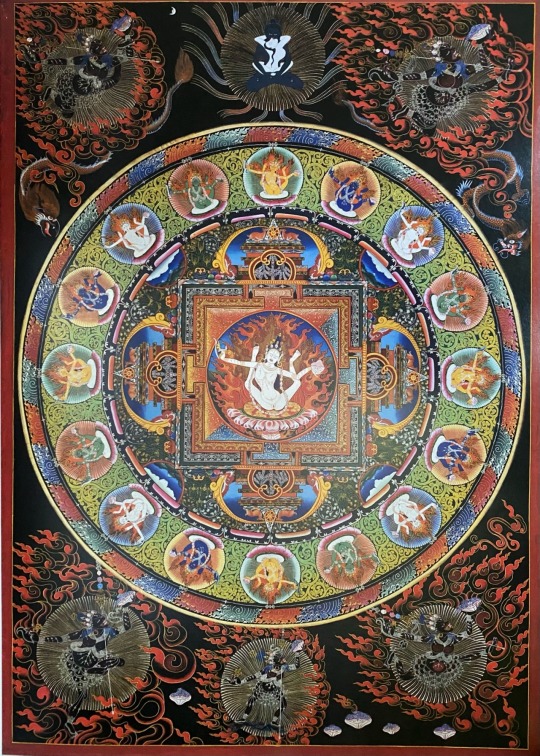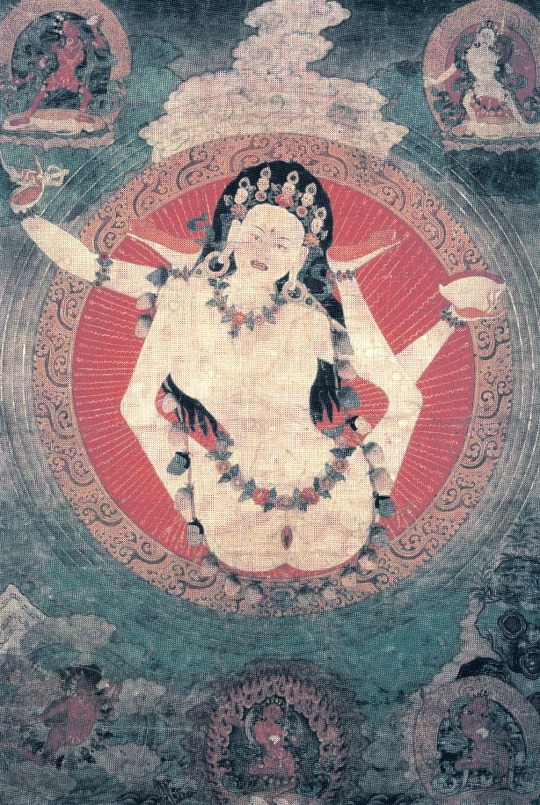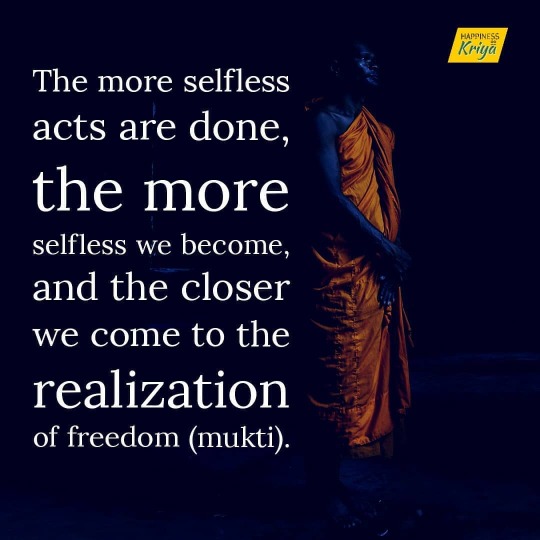#sukhasiddhi
Photo

Sukhasiddhi Dakini, Nepal
97 notes
·
View notes
Text



The Wheel of Life - Samsara
Talon Abraxas
The Wheel of Life (called the Bhavachakra in Sanskrit) represents the cycle of birth and rebirth and existence in samsara.
23 notes
·
View notes
Text



“Dakini Mandala: Gateway to Celestial Bliss” by Romio Shrestha, with text by Ian A. Baker.
From “Celestial Gallery” (2000).
Central image: Sukhasiddhi Dakini
Vajrayogini, is a representation of complete Buddhahood in female form, whose practices are associated with the Chakrasamvara Cycle of Anuttarayoga Tantra.
24 notes
·
View notes
Text

Sukhasiddhi was born into a poor family and was the mother of three sons and three daughters. She was a very kind and compassionate person who once gave away the only food in her house and was disowned by her own family. She went to Oddiyana, which was thought to be the land of dakas and dakinis, and met Virupa, a mahasiddha who became her guru. Sukhasiddhi attained complete realization very quickly, and he was the root teacher of the Tibetan yogi Khungpo Naljor.
15 notes
·
View notes
Text

IN THE CENTER OF CONCENTRIC SPHERES, an emanation of Vajrayogini called Sukhasiddhi, the "attainment of bliss," balances on a flaming lotus.
Initiatress into the unfolding mysteries of birth and death, into all that remains unknown, Sukhasiddhi expresses the Tantric spirit of the Divine Feminine, which guides spiritual aspirants to realms of selfless freedom.
Tantric Buddhism, the "Diamond Vehicle" (Vajrayana), does not suppress the powerful forces of human existence, but celebrates them in ecstatic imagery that cuts to the core of experience. Brandishing a flaying knife and garlanded in skulls-taking as ornaments what is normally rejected-Sukhasiddhi cuts through hope and fear, attachment and aversion, to unite with all existence. Her chopper (kartrika) severs the roots of illusion, while her upraised skull cup is an offering of the nectar of emptiness, the interdependent miragelike nature of all life.
As the Second Dalai Lama wrote in The Transmission of the Wisdom Dakini, "Above your head visualize a white or red Vajrayogini... Summon and absorb the Wisdom Beings, invoking and receiving their empowerments... Recite the secret mantra. ... One's mind in the form of a white syllable AH - shoots up the central channel [paralleling the spine].
It enters Vajrayogini through the passage of her sexual organ... and dissolves into her heart.
Meditate that the mind becomes one with the Wisdom of Bliss and Emptiness [embodied by] Vajrayogini.*
Female archetypes of enlightened awareness are central to the Tantric form of Buddhism, which envisions the boundless, unconditioned wisdom mind as “feminine" and the compassionate activation of this underlying reality as "male."
The insoluble union of these complementary energies is illustrated at the top of this painting in the form of Buddha Samantabhadra, the "all-beneficent."
This joyful Buddha symbolizes the eros of enlightened mind— the total integration of the poles of feeling and thought, spirit and matter, form and emptiness, bliss and all-penetrating awareness.
Framing this icon of ecstatic union are wrathful dakinis, *sky dancers," who manifest enlightened activity free from conventional perceptions, attitudes, and beliefs. Drinking from skull cups the nectar of pure perception, they imagine without boundaries, emanating from the primordial darkness of infinite possibility in aureoles of flames.
The mandala itself is the primal matrix— the womb door from which all life and experience come forth. According to the Guhyagarbha Tantra, "To understand what is born you must first penetrate what is beyond both birth and death."
Before entering into the light, you must encompass the darkness. The womb door is the gate of all mysteries, a portal between embryo and emanation, and an invitation Into the mind of infinite freedom.
— "Dakini Mandala: Gateway to Celestial Bliss" by Romio Shrestha, with text by lan A. Baker
#yin#dakini#divine feminine#goddess#divine mother#ma kali#kali ma#yin and yang#divine masculine#yang#sacred masculine#higher consciousness#perspective#awareness#sacred sex#flowers#🔥#light body#love#sacred heart#serpents#sacred geometry#manifestation#death and the maiden#freedom#non human animals#art#uploads#twin souls#words
2 notes
·
View notes
Text

Dakani Mandala
In the center of the concentric spheres, emanation of vajrayogini called Sukhasiddhi, “the attainment of bliss” balances on the flaming lotus. Sukhasiddhi expresses the Tantric spirit of Divine Feminine, which guides spiritual aspirants to realms of selfless freedom. Sukhasiddhi cuts through hope and fear, attachment and aversion to unite all the existence. Her chopper serves the roots of illusion, while her upraised skull cup is an offering of nectar of emptiness, the independent mirage like nature of all life.
#Nepal #bhaktapurdurbarsquare #lamathankapaintingschool #buddhism #thangka #thankapainting #thangkaschool #mandala #dakini #sukhasiddhi
28 notes
·
View notes
Photo

𝐇𝐚𝐩𝐩𝐢𝐧𝐞𝐬𝐬𝐊𝐫𝐢𝐲𝐚 The more selfless acts are done, the more selfless we become, and the closer we come to the realization of freedom (mukti). . . . . . . . #freedomKriya #SukhaKriya #HappinessKriya #happiness #love #joy #meditation #minds #enlightenment #refuge #mudra #unionebuddhistaitaliana #illuminazione #egolessyoga #sukhasiddhi #peaceandbliss #infinitespace #shunyata #sunandmoon #nirvana #moksha #nakshatra #anatman #suhkriya #kriya Happiness Kriya https://www.instagram.com/p/B9BErKxFM_x/?igshid=1l00lges1dx6u
#freedomkriya#sukhakriya#happinesskriya#happiness#love#joy#meditation#minds#enlightenment#refuge#mudra#unionebuddhistaitaliana#illuminazione#egolessyoga#sukhasiddhi#peaceandbliss#infinitespace#shunyata#sunandmoon#nirvana#moksha#nakshatra#anatman#suhkriya#kriya
1 note
·
View note
Text
Give up the mind that wants to meditate and calm down. Focus on nothing at all.
Disturbing thoughts and lazy indifference are not liberation.
Remain unstained by thoughts and circumstances.
Rest relaxed in the uncontrived nature of mind, free of elaboration or alteration.
For the benefit of one and all, simply preserve peerless awareness.
- Sukhasiddhi
37 notes
·
View notes
Text
Tilopa The Royal Wonderer

Tilopa was born into the brahmin (priestly) caste – according to some sources, a royal family – but he abandoned the monastic life upon receiving orders from a dakini (female buddha whose activity is to inspire practitioners) who told him to adopt a mendicant and itinerant existence. From the beginning, she made it clear to Tilopa that his real parents were not the persons who had raised him, but instead were primordial wisdom and universal voidness. Advised by the dakini, Tilopa gradually took up a monk’s life, taking the monastic vows and becoming an erudite scholar. The frequent visits of his dakini teacher continued to guide his spiritual path and close the gap to enlightenment. He began to travel throughout India, receiving teachings from many gurus:
from Saryapa he learned of inner heat (Sanskrit: caṇḍalī, Tib. tummo, inner heat);
from Nagarjuna he received the radiant light (Sanskrit: prabhasvara) and illusory body (Sanskrit: maya deha, Tib. gyulu) teachings (refer Chakrasamvara Tantra), Lagusamvara tantra, or Heruka Abhidharma);
from Lawapa, the dream yoga;
from Sukhasiddhi, the teachings on life, death, and the bardo (between life states, and consciousness transference) (phowa);
from Indrabhuti, he learned of insight (prajna);
and from Matangi, the resurrection of the dead body.
During a meditation, he received a vision of Buddha Vajradhara and, according to legend, the entirety of mahamudra was directly transmitted to Tilopa. After having received the transmission, Tilopa embarked on a wandering existence and started to teach. He appointed Naropa, his most important student, as his successor.
Six Words of Advice Tilopa gave Naropa a teaching called the Six Words of Advice, the original Sanskrit or Bengali of which is not extant; the text has reached us in Tibetan translation. In Tibetan, the teaching is called gnad kyi gzer drug – literally, “six nails of key points” – the aptness of which title becomes clear if one considers the meaning of the English idiomatic expression, “to hit the nail on the head.” According to Ken McLeod, the text contains exactly six words; the two English translations given in the following table are both attributed to him.
12 notes
·
View notes
Photo

Sukhasiddhi Dakini, tibetan thangka
128 notes
·
View notes
Text

Sukkhasiddhi Vajra Yogini
The Vajra Yogini (VY) Tantras originally arose from within the Chakrasamvara Tantras, and across time as well as great lineage masters, arose various VY lineages like the Naro Kechari, Maitri Kechari and Indra Kechari traditions.
Of these, the white Sukhasiddhi VY is a lesser-known lineage of VY that stems from within the Shangpa Kagyu lineage.
The name Sukkhasiddhi implies a connection between Khyungpo Naljorpa and his Indian yogini teacher,
Sukhasiddhi. She is in the unique posture of revealing her secret organ in the manner akin to giving birth. This represents the emphasis of this lineage on powa (mind transference) to a pure land. This is a special practice of death meditation that prepares the practitioner to eject their mind to a pure land which, in the case of VY, is known as Kechara Paradise.
—-
To cause yourself and your life to be intensely filled with happiness, do everything you can to give happiness to others.
Do all the good you can. By all the means you can. In all the ways you can. In all the places you can. At all the times you can. To all the people you can.
As long as ever you can.
May you be well and happy my friends.
I am grateful for your interest in Dharma and following my blog.
Any mistakes are solely my own and not the fault with the Dharma or masters quoted here.
#buddha#buddhist#buddhism#dharma#sangha#mahayana#zen#milarepa#tibetan buddhism#thich nhat hanh#dhammapada#karma#mindfulness#dakini#four noble truths#pure land#equanimity#avalokitesvara#manjushri#bodhisattva#tsongkhapa#padmasambhava#amitabha#atisha#shantideva#vajrasattva#vajrayogini#vajrapani#green tara#medicine buddha
3 notes
·
View notes
Video
Here Yashobodhi describes the background of the Tonglen practice, through the Shangpa lineage, from two women in the 10th and 11th centuries; the dakinis Niguma and Sukhasiddhi.⠀ ⠀ Still Breathing in the World: A Journey into the Heart of Tonglen with Yashobodhi⠀⠀⠀ A solstice series exploring a beautiful meditation practice from the Tibetan tradition⠀⠀⠀ ⠀⠀⠀ Sundays: December 12, 19, 26 + every day in Christmas week (December 20-24 incl.)⠀⠀⠀ ⠀⠀ Find out more and reserve your space:⠀⠀ ⠀⠀ http://thebuddhistcentre.com/live/#tonglen (LINKINBIO)⠀⠀ ⠀ #Triratna #Dharma #Buddhism #Buddhist #tonglen #meditation #breathing #kindness #compassion @yb_lucia⠀ Images: Artist unknown; http://likeanillusion.com/dakinis.shtml⠀ https://www.instagram.com/p/CXL1p9WjKuc/?utm_medium=tumblr
0 notes
Text

Dakani Mandala
In the center of the concentric spheres, emanation of vajrayogini called Sukhasiddhi, “the attainment of bliss” balances on the flaming lotus. Sukhasiddhi expresses the Tantric spirit of Divine Feminine, which guides spiritual aspirants to realms of selfless freedom. Sukhasiddhi cuts through hope and fear, attachment and aversion to unite all the existence. Her chopper serves the roots of illusion, while her upraised skull cup is an offering of nectar of emptiness, the independent mirage like nature of all life.
8 notes
·
View notes


